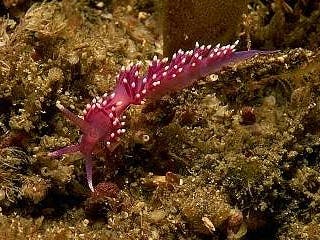Selsey's Violet Sea Slug

The thought of slugs for many conjures up the image of a fat, slimy garden slug, however under the water they become something rather special. The correct name, nudibranch, is made up from the Latin and Ancient Greek words meaning “naked” and “gills”. They are a soft bodied mollusc that shed their shell after the larval stage. Sea slugs come in many magnificent colours and amazing forms. With over 3,000 known species, Anya Frampton, Selsey's resident SSI Marine Ecology Instructor introduces the violet sea slug - Flabellina Pedata.

The name gives you a clue to this one’s choice of colour as they are a bright pink/purple nudibranch. Very distinctive, they are often the first UK sea slug that divers get to recognise. The best way to describe them is imagine a slug, and visualise along its body cerata/projections that look a little like tassels. These cerata are arranged in bunches and each one has a white tip.
The sea slug's head has two sets of forks – the top one is the rhinophores and the second the oral process or mouth, these have a white tip to them.
Liking to stay in one place they live on the hydroids that they like to eat. A common nudibranch they are however only generally seen as individuals or mating pairs. Once mated they lay their eggs as a thin white thread that wraps around the base of their favourite food.
It is often the eggs that nudibranch hunters spot first as the white colour of the eggs set against the red/orange background stands out and the egg thread is generally much bigger than the parents who are about 2cms when fully grown.
Divers tend to either love or hate nudibranch, but with at least 30 species to be found off the beach at Selsey, spotting these small beauties and capturing them on camera is a lot of fun.
If you have any questions about the different sea slugs found off Selsey, then contact Anya Frampton, Selsey's resident SSI Marine Ecology Instructor at Mulberry Marine Experiences.
Image courtesy of Anya Frampton